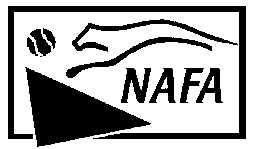
Articles of a broader interest to Flyball enthusiasts are published in The Finish Line.
Copyright © 1995 by NAFA. Contents may be reproduced for use by members of teams associated with NAFA. Others may reproduce providing credit is given to NAFA.
It has been almost two years since the electronic starting, timing and passing lights have been available to tournament directors all around North America. In that time, the level of competition has become such that all competitors have an equal chance of winning their division. In my opinion, the lights have made way for some very exciting Flyball competition. It has also made it easier for a tournament director to find someone willing to be a line judge (now that they dont have to call the passes). Still, the line judges responsibilities are formidable. Tournaments now average over seven races an hour. That is a lot of activity on the lines. I applaud everyone who is willing and able to meet the challenge of being a line judge. However, there seems to be a trend towards the line judges not being up to meeting these responsibilities.
It may look easy but it is not. A good line judge knows the rules and has an understanding of how a tournament is run. This means that a tournament director must carefully choose those people who will be sitting on the line. After all, sitting on the line for the whole weekend, watching dogs run back and forth, is not an easy task. The individual chosen should be someone you would want to sit on the line when you were trying to win your division. We, as competitors, must also be willing to put as much dedication and commitment into judging, as we put into our racing. We must all work on this problem together, in order to insure that all our tournaments run at high standards.
As I read through the list of Approved Head Judges the other day, I noticed
many names who I dont believe have judged a tournament in the last three to
four years, if ever. Many have not judged under the Electronic Judging System
that we are now using at nearly all sanctioned tournaments. At this time I
would like to ask all of the judges that I have just described to either
solicit an assignment where they can judge a division at a tournament under
another judge or consider having their name removed from the list of Approved
Head Judges. Because of the need for judges, I hope many of you will volunteer
to judge a division in the near future. If you dont feel that you will want to
judge in the future, please notify Clyde Moore or Dave Samuels.
The following is the list of Head Judges, approved and provisional.
As neither Dave Samuels or Kevin Hughes are running for re-election to the
Board of Directors, I would like to take this opportunity to thank both of them
for all their hard work. Im sure both will continue to promote Flyball
activities in the future.
It was a real pleasure to meet a lot of Flyball people in Houston, now I'm
looking forward to meeting the Flyball people in Minnesota on November 10, 11 &
12. The board has had a busy year with many accomplishments and problems
solved. Best of the season to everybody.
At the Board meeting held on July 14, 1995 in Houston, the Board voted
unanimously to adopt the following:
Rule 6:16(d) Box Malfunction
The proper procedure to follow when a box malfunctions during a heat is as
follows:
Steve McAvoy, Chairman, Regulatory Committee
Executive Directors Corner
by Clyde Moore
NAFA Approved Judges:
NAFA Provisional Judges:
Words from the Chairman
by Bob Murray
Note to all Regional Directors
by Clyde Moore
Heats that are meaningless to the outcome of a sanctioned tournament
are not to be run just for the sake of allowing teams to accumulate more
points towards Flyball Titles.
This means that in the case of a best 3 out of 5 format, you will not be
allowed to run any more heats after one team has won three heats. The same
principle holds for 2 out of 3 formats, so to guarantee more heats per race
you might want to go to a 3 out of 5. If tournament directors want to run 5
heats in a race they would have to use a scoring system where each heat counts.
The Final Word
by Steve McAvoy
If you have any questions concerning this or other rules and your rule book
does not completely answer your question, contact me and I will be glad to help
you understand the rules.
NAFA and the NAFA logo
are registered trademarks of the North American Flyball Association, Inc.